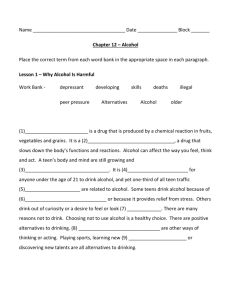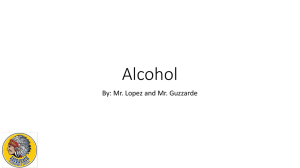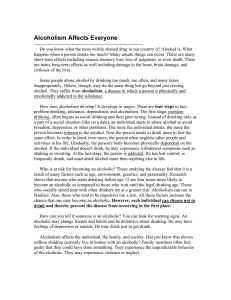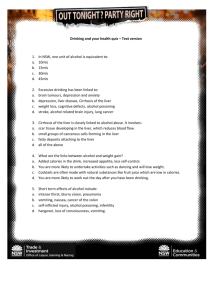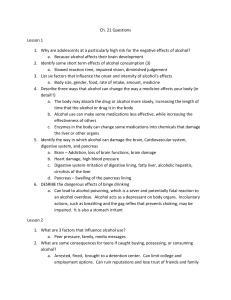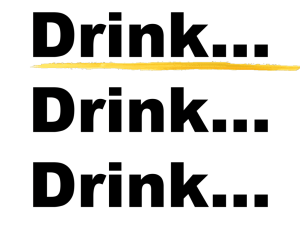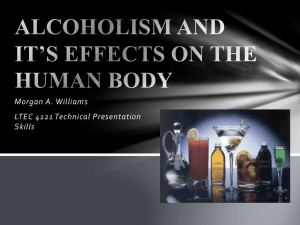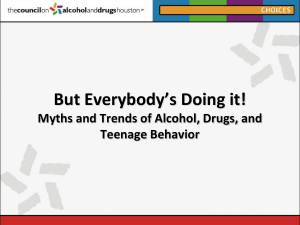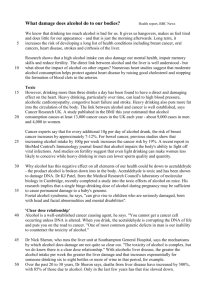chapter-12-7b
advertisement
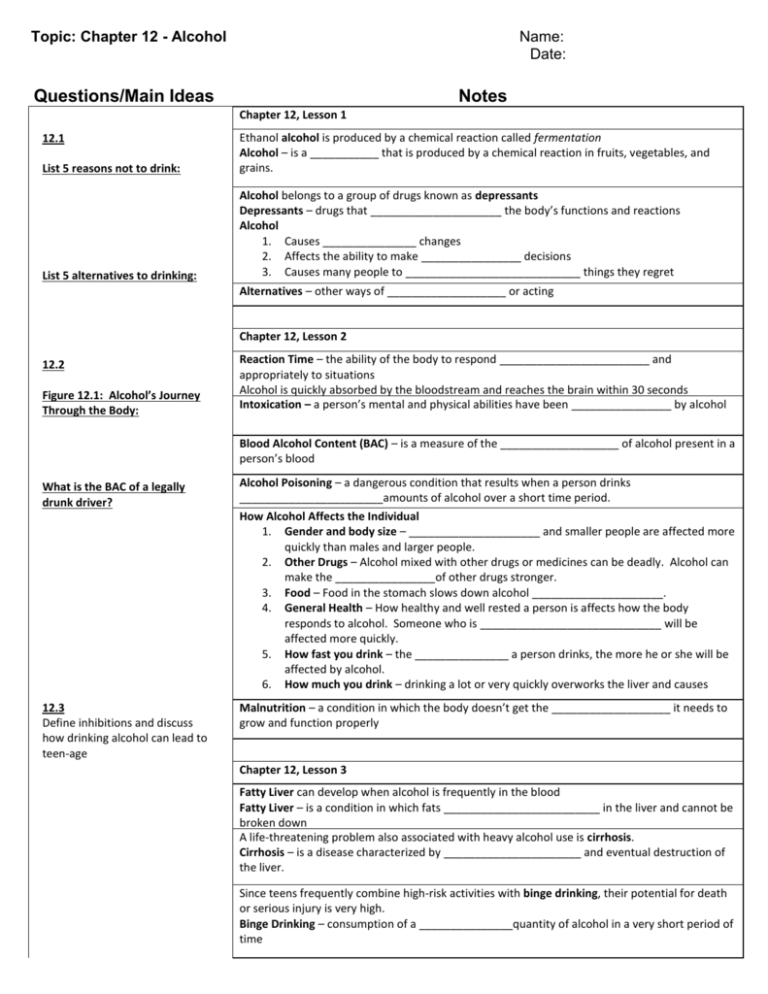
Topic: Chapter 12 - Alcohol Name: Date: Questions/Main Ideas Notes Chapter 12, Lesson 1 List 5 reasons not to drink: Ethanol alcohol is produced by a chemical reaction called fermentation Alcohol – is a ___________ that is produced by a chemical reaction in fruits, vegetables, and grains. List 5 alternatives to drinking: Alcohol belongs to a group of drugs known as depressants Depressants – drugs that _____________________ the body’s functions and reactions Alcohol 1. Causes _______________ changes 2. Affects the ability to make ________________ decisions 3. Causes many people to ____________________________ things they regret 12.1 Alternatives – other ways of ___________________ or acting Chapter 12, Lesson 2 12.2 Figure 12.1: Alcohol’s Journey Through the Body: Reaction Time – the ability of the body to respond ________________________ and appropriately to situations Alcohol is quickly absorbed by the bloodstream and reaches the brain within 30 seconds Intoxication – a person’s mental and physical abilities have been ________________ by alcohol Blood Alcohol Content (BAC) – is a measure of the ___________________ of alcohol present in a person’s blood What is the BAC of a legally drunk driver? 12.3 Define inhibitions and discuss how drinking alcohol can lead to teen-age Alcohol Poisoning – a dangerous condition that results when a person drinks _______________________amounts of alcohol over a short time period. How Alcohol Affects the Individual 1. Gender and body size – _____________________ and smaller people are affected more quickly than males and larger people. 2. Other Drugs – Alcohol mixed with other drugs or medicines can be deadly. Alcohol can make the ________________of other drugs stronger. 3. Food – Food in the stomach slows down alcohol _____________________. 4. General Health – How healthy and well rested a person is affects how the body responds to alcohol. Someone who is _____________________________ will be affected more quickly. 5. How fast you drink – the _______________ a person drinks, the more he or she will be affected by alcohol. 6. How much you drink – drinking a lot or very quickly overworks the liver and causes _________________________ Malnutrition – a condition in which the body doesn’t get the ___________________ it needs to grow and function properly Chapter 12, Lesson 3 Fatty Liver can develop when alcohol is frequently in the blood Fatty Liver – is a condition in which fats _________________________ in the liver and cannot be broken down A life-threatening problem also associated with heavy alcohol use is cirrhosis. Cirrhosis – is a disease characterized by ______________________ and eventual destruction of the liver. Since teens frequently combine high-risk activities with binge drinking, their potential for death or serious injury is very high. Binge Drinking – consumption of a _______________quantity of alcohol in a very short period of time Using alcohol can lower inhibition – is a conscious or unconscious _________________ of a person’s own behaviors or actions When an unborn baby is exposed to alcohol, it can develop fetal alcohol syndrome – is a group of alcohol-related ___________________________________ that include both physical and mental problems. Chapter 12, Lesson 4 Teens 15 years and younger are 4 times more likely to develop and addiction than older individuals Addiction – is a physical or psychological ________________ for a drug People who are addicted to alcohol suffer from alcoholism – is a progressive, chronic disease involving a mental and physical need for alcohol. 5 Major Symptoms of Alcoholism 1. Denial – the do not feel they have a problem and usually the last to admit they need help. 2. Craving – person has a strong need for the drug 3. Loss of Control – unable to limit his or her drinking 4. Tolerance – process in which your body needs ________ of a drug to get the same effect. 5. Physical Dependence – type of addiction in which the ___________ itself feels a direct need for a drug. Enabling includes making __________________ for or lying on behalf of the alcoholic. Enablers – persons who create an atmosphere in which the alcoholic can comfortably continue his or her unacceptable behavior. There is a difference between alcoholism and alcohol abuse – a pattern of drinking that results in one or more well-defined behaviors within a 12-month period. Chapter 12, Lesson 5 An intervention can help overcome an alcoholic’s denial that he or she has a problem. Intervention – a ______________________ in which family and friends get the problem drinker to agree to seek help Relapse – a return to the _______________________________ after attempting to stop Recovery starts only after the alcoholic makes the COMMITMENT to never drink again. Recovery – the process of learning to live an ______________________________ life Withdrawal – the physical and psychological ______________________ that occur when someone stops using an addictive substance (mild to severe – headaches, tiredness, strong mood swings, nausea) Steps Along the Road 1. Admission 2. Counseling 3. Detoxification – the physical process of _____________________ the body from an addictive substance 4. Resolution Summary 12.1 - Teens who drink risk damaging their health. Why, then, do some young people drink alcohol? 12.2 - Long-term use of alcohol can lead to malnutrition. Define malnutrition and explain why the calories in alcohol can be bad! 12.3 - What are some ways in which experimenting with alcohol can interfere with a teen’s future? 12.4 - Alcoholism is a disease that can shatter a person’s entire life and disrupt the lives of those around him or her. How widespread is this disease in the United States? p.291
